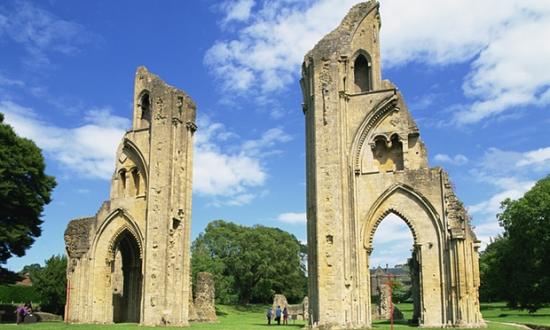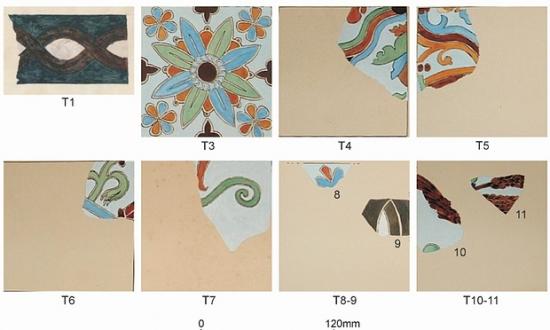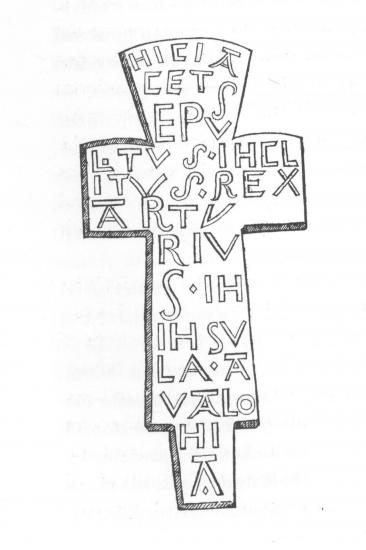Archaeological study dismisses abbey’s links to King Arthur and Joseph of Arimathea, saying many stories were created to raise funds after a fire
Maev Kennedy
Source - http://www.theguardian.com/science/2015/nov/23/glastonbury-myths-made-up-by-12th-century-monks
 Glastonbury Abbey. The supposed grave of King Arthur was really a pit filled with builders’ rubble, says the study. Photograph: Eurasia Press/Getty Images/Photononstop RM
Glastonbury Abbey. The supposed grave of King Arthur was really a pit filled with builders’ rubble, says the study. Photograph: Eurasia Press/Getty Images/Photononstop RM
A four year study by archaeologists has comprehensively demolished cherished myths about one of the most romantic religious sites in England, Glastonbury Abbey.
Those feet, immortalised in William Blake’s poem Jerusalem, never walked on the green and pleasant land of Glastonbury; the oldest church in England was not built there by Christ’s disciples; Joseph of Arimathea’s walking stick does not miraculously flower every Christmas after 2,000 years. And it turns out that the supposed link with King Arthur and his beautiful queen, Guinevere, is false too – invented by 12th-century monks faced with a financial crisis in the wake of a disastrous fire.
Furthermore the team of 31 specialists, led by Roberta Gilchrist, professor of archaeology at the University of Reading, found that generations of her predecessors working at the abbey were so bewitched by the legends that they either suppressed or misinterpreted evidence that did not fit.
However, new discoveries do suggest a previously unknown glassworks dating from as early as the seventh century, the earliest major glassworking site from Saxon England. Ceramic fragments found at the site also prove that wine was imported from the continent even earlier than that.
“Glastonbury is a remarkable site, and we would not want to take away from its fascination for so many people. What we have done is looked carefully at all the unpublished records of 20th-century excavations and any surviving evidence,” Gilchrist said.
 Fragments of medieval glass and sculpture from Glastonbury Abbey. Photograph: Glastonbury Abbey
Fragments of medieval glass and sculpture from Glastonbury Abbey. Photograph: Glastonbury Abbey
The abbey, and other sites in the town linked to the legend of the holy grail, are major attractions for both tourists and pilgrims attracted by the Christian legends and a galaxy of new age beliefs.
One story says that Christ himself came and built a church in honour of his mother. However, the better known story is of the holy thorn, for which Gilchrist could find no evidence before the 17th century. It tells that Joseph of Arimathea came to Glastonbury from the Holy Land, planted his walking stick which flowered miraculously, and built a church.
The legend is so widely cherished that a posy from the thorn tree is sent every December for the Queen’s Christmas morning breakfast table, and when a thorn tree on a nearby hilltop that was said to have been grown from Joseph’s tree was vandalised, the news went round the world.
Gilchrist found no early accounts of a special tree in the abbey, and the gnarled thorn now seen in the grounds is a common hawthorn which naturally flowers in midsummer and midwinter.
A 12th-century historian, William of Malmesbury, left a description of an ancient wooden church which Gilchrist believes he clearly saw. However William was careful to say that he had only been told that it was built by Christ’s disciples. His original account only survives in much later versions, into which extra material was inserted – probably by the monks retrofitting an ancient history to boost their status.
“It may well be that what he saw was an Anglo-Saxon wooden church, which could have dated back to the seventh century or even a little earlier, which to him would have been unimaginably ancient, but he would have had no means of dating it more precisely.”
The monks’ greatest ingenuity came after a disastrous fire in 1184 which left them the problem of rebuilding with few resources and no major relics to attract pilgrims. The solution was the increasingly popular legend of King Arthur, creator of the Knights of the Round Table, the identification of Glastonbury as the legendary isle of Avalon where he was buried, and the supposed discovery of the grave of Arthur and Guinevere – together with a helpful lead cross with a Latin inscription naming the king. The cross has been lost for centuries, but Gilchrist says that images suggest it was a careful piece of fakery based on an Anglo-Saxon original.
 An image of the now lost cross. Photograph: Glastonbury Abbey
An image of the now lost cross. Photograph: Glastonbury Abbey
When the church was rebuilt, she says, it was in a consciously old-fashioned style, giving the impression of a much older building.
“With the other legends there is a possibility of genuine belief or misunderstanding, but with Arthur and Guinevere I’m afraid there can be no question – the monks just made them up.”
In the 1950s and 60s Ralegh Radford, who was still working on his Glastonbury findings into his 90s, excavated and announced that he had rediscovered Arthur’s gravesite, along with the most ancient British Christian cemetery, and a Saxon cloister which was the oldest in England. He was wrong on all counts, Gilchrist says, his cemetery was really medieval, his royal grave was a pit with builders’ rubble from the 11th to 15th century, and new geophysical work on the foundations he found shows that the walls do not line up and so are almost certainly not a cloister at all.
The new findings will be gently incorporated into the interpretation of the site and a new guidebook.
“We are not in the business of destroying people’s beliefs,” Gilchrist, who is now a trustee of Glastonbury, said. “A thousand years of beliefs and legends are part of the intangible history of this remarkable place.”